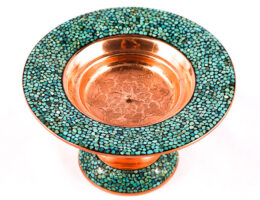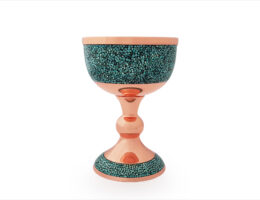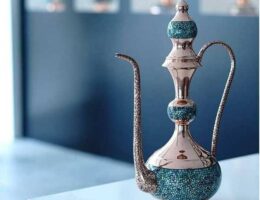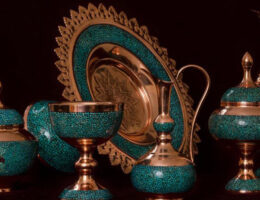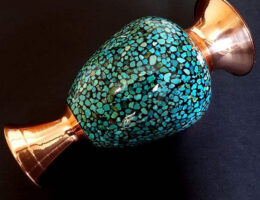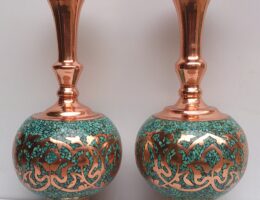IRAN ART EXHIBITION: ALL YOU NEED TO KNOW ABOUT TURQUOISE OF IRAN IS HERE
Turquoise is an opaque, blue to green gem material that has been worn, used, and appreciated by different civilizations for thousands of years. Originally called piruzeh in Persian, the gem has spiritual value in Persian culture is such that its name carries the meanings of victory, triumph, and prosperity. In Persian literature, turquoise has been celebrated by poets, and various legends and beliefs are associated with it.
Archeological discoveries from the Deh Luran Plain in western Iran indicate that turquoise was first utilized around 7000 BCE. The quantity of turquoise artifacts discovered in burial sites suggests the importance of this mineral in this ancient civilization’s traditions. While the estimated age of these artifacts is valid, no scientific study has linked them to any specific deposit.
The Neyshabur (Latinized as Nishapour) deposit is known for yielding turquoise with unique color and quality. This production has historically been known as “Persian turquoise”, yet Iran’s turquoise deposits were never limited to Neyshabur. Other important mines include the Baghu deposit in southern Semnan Province and the Shahr-i Babak deposit in western Kerman Province, the latter of which was mentioned in Marco Polo’s Book of the Wonders of the World between 1390 and 1430.
Located in the Razavi Khorasan Province of northeastern Iran, 53 km from the city of Neyshabur, the Neyshabur mine has produced the majority of Iranian turquoise for more than a millennium. Yet in recent decades there have been claims that the mine is on the verge of closure, that its turquoise quality has diminished, or that it is running out of material. Such claims often carry enormous weight with consumers. After visiting the Neyshabur turquoise mine in 2020, a report was conducted on the current state of the mine. This article seeks to uncover the facts and offer objective insight on the current state of the Neyshabur turquoise mine.
LOCAL GEOLOGY
The Neyshabur turquoise mine is located at the far east end of the Quchan-Sabzevar magmatic arc. This arc in northeastern Iran indicates a complex tectonic-magmatic evolution and is characterized by extensive magmatic activity with a range of geochemical signatures. Magmatic activities started there during the Cretaceous, peaking during the Eocene (40 Ma) and then continuing into the Plio-Pleistocene (2 Ma). The volcanic and plutonic rocks of the arc can be divided into three groups, including Eocene intermediate igneous rocks, Oligocene acidic igneous rocks, and Miocene-Pleistocene alkaline basalts.
Major rock units of the Neyshabur mine are divided into three groups: volcanic, subvolcanic intrusions, and hydrothermal breccia.
THE NEYSHABUR TURQUOISE MINE
IRAN ART EXHIBITION: Previously owned by various organizations, the Neyshabur turquoise mine became a cooperative in 2003. It is currently owned by shareholders who are all residents of Olia and Sofla, the two parts of Ma’adan village. Some of these shareholders work in the mine, while the rest manage businesses related to cutting or selling. The mine is located at Raish Mountain, where turquoise has been recovered for millennia.
Another technique, deep-vein mining, was the most difficult and dangerous in centuries past. Whereas once only gold and silver were considered valuable enough to justify digging underground in other parts of the world, turquoise carried such importance in Persian culture that some deep shafts in the mountain date back many centuries. After a suitable site was found, tunnels were excavated in the rock to remove the vein. Narrow vertical shafts were driven through the rock, widening out to horizontal galleries where the ore was found. Sometimes horizontal adits1 from a hillside were driven as well. Working below ground, the miners had to deal with the need for lighting and the dangers of poor ventilation. Some of these old mining operations are still standing, while others have collapsed.
TURQUOISE PRODUCTION
Among Iran’s three main turquoise deposits, only the Neyshabur mine is dedicated to turquoise production. Baghu turquoise is from the Kuh Zar mine, a gold and copper deposit, and Shahr-I Babak turquoise comes from the Meiduk mine, a porphyry copper deposit. The mining strategies at Kuh Zar and Meiduk are focused on the extraction of gold and copper, respectively, rather than turquoise. Despite the fine color of Baghu turquoise, the Kuh Zar mine currently reports no official production of turquoise. On the other hand, the Meiduk open-pit mine is working with the Shahr-I Babak turquoise cooperative to manage the turquoise extracted in the process of copper mining. Open-pit mining has caused an unstable turquoise yield. When there is a turquoise vein on one of the horizontal levels known as benches, the mine can produce an average of three tons per month, but otherwise there could be no production for months. More information on the Kuh Zar and Meiduk mines will be published in subsequent reports.
With more than 200 workers, an average production of four tons of rough turquoise per month, and an annual production of 40 to 42 tons, Neyshabur is Iran’s largest turquoise mine. Although the Main tunnel is the largest, as shown in table 2, more than 70% of the mine’s turquoise comes from the Zahk tunnel.
Mine to Market. Turquoise Quality. Rough turquoise from Neyshabur is classified into four categories based on color, porosity, shape, and size.

IRAN ART EXHIBITION: More than 300 lapidary workshops have been established in Ma’adan village and the city of Neyshabur.
Mashhad, Tehran, Esfahan, and Neyshabur are the main centers for Iranian turquoise cutting, and they also have an active export market due to tourism and international flights.
CONCLUSIONS
Despite the Neyshabur mine’s productivity and tradition, this turquoise has yet to find its place in the global market. It has been plagued by claims that the mine is closing. Also, the generic term “Persian turquoise” has been hindered by inconsistent quality and pricing standards, causing some customers to question the product. Although most turquoise in the global market is either stabilized or treated, Iranian traders insist on focusing on untreated turquoise. While the untreated version of the gemstone may be important to some customers, its high price, limited quantity, and sensitivity to chemicals are a drawback for others. In recent years many private companies in Iran have focused on treatment, improving the quality of second and third color grade material to produce commercial-quality turquoise for trading in the domestic and global market.
With a cohesive marketing and pricing strategy, turquoise from Neyshabur and other Iranian mines could once again compete in the global market.

